The atomic bomb of Nagasaki and its impact on motherhood in Japan
The atomic bombing of Nagasaki transformed the understanding of motherhood in Japan. Survivors' remaining guilt and fears shape their lives and those of their children. Find out more!

The atomic bomb of Nagasaki and its impact on motherhood in Japan
When Kikuyo Nakamura's adult son discovered unusual bumps on his back, she assumed it was just a rash. Still, she urged him to go to the hospital—better to be careful than careless. Hiroshi, their second son, was born in 1948, three years after the atomic bombing of Nagasaki. As a bombing survivor, Nakamura had long feared passing on health problems to her children.
Diagnosis of leukemia
In 2003, at age 55, Hiroshi went to the hospital. Two days passed without her hearing from him. Then three. Finally a week. Eventually, Nakamura made her way to the hospital, where her son told her, “They will do more tests.” The results showed he had stage 4 leukemia - an advanced form of blood cancer that had spread to other parts of the body. According to Nakamura, the doctor told her that she had given her son cancer - and suggested that the radiation that had affected him had been passed on to him while breastfeeding.
A burden of guilt and stigma
When Hiroshi died six months later, his mother was left with the thought that she had, so to speak, killed him; a thought that still torments her more than two decades later. "I was overwhelmed with guilt and suffering... Even now I still believe what the doctor said I caused. That guilt lives on within me," said Nakamura, now 101 years old.
After a nuclear attack, people who have been exposed to radiation are generally advised to stop breastfeeding immediately. But experts emphasize that there is no concrete evidence that the first generation of "hibakusha" - survivors of the atomic bombs of World War II - can pass cancer-causing material to their children years after exposure.
Survivors' memories
As the 80th anniversary of the U.S. bombings of Hiroshima and Nagasaki approaches, older survivors — some, like Nakamura, over 100 years old — are sharing their stories of suffering and resilience while they still can. Many of them were young women, either pregnant or of childbearing age when the bombs fell, and lived much of their lives in the shadow of fear and stigma.
Doctors, neighbors, even friends and family had told them that their exposure to radiation could cause them to give birth to children with illnesses or disabilities - if they could become pregnant at all.
Long-term health risks
Even when infertility or a child's disability had nothing to do with radiation exposure, hibakusha women often felt blamed and excluded. Women with visible scars from the explosions faced marriage problems. Physical wounds were harder to conceal and more clearly indicated exposure. In a society where a woman's value was closely tied to marriage and motherhood, this stigma was particularly damaging.
This led many female survivors - many of whom suffered from PTSD (post-traumatic stress disorder) - to "hide that they were hibakusha," said Masahiro Nakashima, a professor of radiation studies at Nagasaki University.
Lifelong scars
Radiation exposure also had an impact on second generation survivors in some cases, depending on the timing of pregnancy. The embryonic phase – which usually lasts from the 5th to the 15th week – is particularly sensitive for brain and organ development. Women exposed to radiation during this period had a higher risk of giving birth to children with intellectual disabilities, neurological problems and microcephaly, according to studies by the joint Japan-U.S. Radiation Effects Research Foundation (RERF).
Further research revealed that hibakusha women themselves faced long-term health risks. A 2012 RERF study found that radiation exposure from a nuclear bomb increased the risk of cancer for the rest of a life. Among women aged 70, the rate of solid cancers increased by 58 percent for every gray of radiation their bodies absorbed by age 30. A gray is a unit that measures how much radiation energy a body or object absorbs.
Nakamura was 21 years old and hanging laundry outside when the bomb fell on Nagasaki on August 9, 1945. It was 5 kilometers from the epicenter - slightly outside what experts call the area of "total destruction." The young mother saw a bright light, followed by a loud bang and a huge gust of wind that threw her into the air. When she regained consciousness, her house was in ruins - furniture was scattered everywhere and broken glass littered the floor. She called out to her own mother, who had helped her care for her eldest son.
Psychological trauma and social pressure
Although Nakamura himself did not appear to suffer any effects from radiation exposure, the psychological trauma remained. She feared the stigma could be passed on to her grandchildren. "If people knew that my son died of leukemia, especially before they (my grandchildren) got married, others might not want them to get married. I made sure my children understood that. We kept it in the family and didn't tell anyone how he died," Nakamura explained.
Encouraged by other survivors, she finally spoke publicly about her son's cancer in 2006, three years after his death. "I received calls and even letters from people who had heard my story. It made me realize how serious the problem of hereditary health effects is in Hiroshima and Nagasaki," she continued. Although she now knows that it is unlikely that she caused her son's illness, the guilt remains a constant burden for her as a mother.
A different survivor experience
The special burden of the hibakusha mother is something that Mitsuko Yoshimura, now 102 years old, was never able to experience. Separated from her parents and sister at a young age, she always longed for a family. She moved to Nagasaki to get a good job in payroll at Mitsubishi just months before U.S. troops dropped the bomb and turned the city into hell.
“When I stepped out into the street, I saw people with bleeding heads, people with skin peeled off their backs,” she recalled. Just a kilometer from the epicenter of the explosion, their survival was a true miracle. In the months that followed, she stayed behind to help the injured. But her body also suffered. "My hair was falling out. Every time I tried to comb it with my hands, strands would fall out one by one," Yoshimura said. She continued to spit blood regularly for several months after the bombing.
Despite all this challenge, she married a year after the war ended. Her husband was also a survivor of the atomic bombing, and their marriage marked a new beginning for them as a couple. But the child they wanted was never born. She had two miscarriages and one stillbirth.
Valuable lessons for the future
Yoshimura now lives alone; her husband died years ago. In her home in Nagasaki, where there might otherwise be photos of children and grandchildren, there are dolls instead - a quiet replacement for what was lost, she said. At their advanced age, Nakamura and Yoshimura know that they don't have much time left. This gives them a stronger drive to educate younger generations about the consequences of nuclear war.
"People really need to think carefully. What's the point of winning or losing anyway? The desire to expand a country's territory or gain more power - what are people really looking for?" Nakamura asked. "I don't understand it. But what I feel deeply is the utter futility of war," she concluded.

 Suche
Suche
 Mein Konto
Mein Konto
